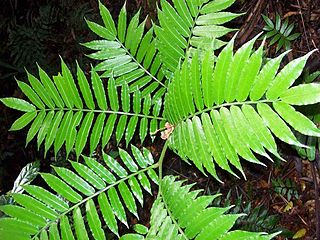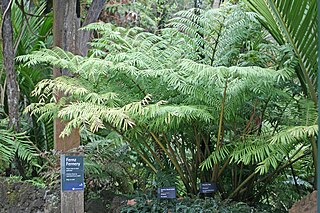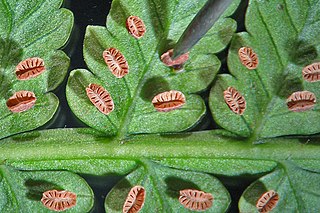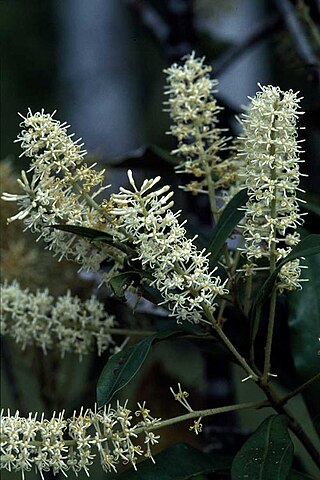
Marattiaceae is the only family of extant (living) ferns in the order Marattiales. In the Pteridophyte Phylogeny Group classification of 2016, Marattiales is the only order in the subclass Marattiidae. The family has six genera and about 110 species. Many are different in appearance from other ferns, having large fronds and fleshy rootstocks.
Saint Helena, Ascension Island and Tristan da Cunha, as well the other uninhabited islands nearby, are a haven for wildlife in the middle of the Atlantic Ocean. The islands are or were home to much endemic flora and fauna, especially invertebrates, and many endemic fish species are found in the reef ecosystems off the islands. The islands have been identified by BirdLife International as Important Bird Areas for both their endemic landbirds and breeding seabirds.

Lemurophoenix halleuxii is a species of palm tree, the only species in the genus Lemurophoenix. It is found only in Madagascar. It is threatened by habitat loss and overcollection. There are perhaps 300 mature individuals remaining in the wild.
Bupleurum kakiskalae is a species of flowering plant in the family Apiaceae. It is endemic to western Crete, an island which is part of Greece.
Naufraga balearica is an extremely rare species of flowering plant in the family Apiaceae, and the only species in the genus Naufraga. It is endemic to the Spanish island of Majorca, where it is found only at the base of cliffs at the north of the island near Pollença. A population was discovered on Corsica in 1981, but it had died out by 1983, and it is not clear whether it arrived naturally. Its natural habitats are Mediterranean-type shrubby vegetation and rocky shores.

Anogramma ascensionis, the Ascension Island parsley fern, is a species of fern in the family Pteridaceae that is endemic to Ascension Island, a volcanic island in the South Atlantic Ocean. It is one of eight putative species in the genus Anogramma. It was thought to have become extinct due to habitat loss, until four plants were found on the island in 2010. Over 60 specimens were then successfully cultivated at Royal Botanic Gardens, Kew and on Ascension Island. It is now classified as Critically Endangered.

Danaea kalevala is a species of fern belonging to the family Marattiaceae. It is endemic to rainforests of the Lesser Antilles islands in the Caribbean.

Diana's Peak is the highest point, at 818 metres (2,684 ft), on the island of Saint Helena, a British overseas territory in the South Atlantic Ocean. It is of volcanic origin. The mountain and its surroundings with a total area of 81 ha were proclaimed a national park in March 1996, the first on the island. It is a preserve of several endangered endemic species, including tree fern, he cabbage and black cabbage trees, and whitewood. The park contains walking paths connecting the peaks - Mt. Actaeon (814m), Diana's Peak and Cuckold's Point (815m). The two shorter peaks are topped by large Norfolk pines. On the northern slopes there is a nursery for endemic species.

Ptisana salicina, or king fern, is a species of fern native to Norfolk Island, New Zealand and the South Pacific. Large and robust with a distinctive tropical appearance, it has fronds up to 5 metres tall that arise from a starchy base that was a traditional food for the Maori. It has several other common names including para, tawhiti-para, and horseshoe fern.
Justicia flaviflora is a species of herbaceous plant in the family Acanthaceae. It was previously classified as Beloperone flaviflora. The species is endemic to the island of Trinidad in the Caribbean republic of Trinidad and Tobago where it is only known from near the peaks of mountains in the Northern Range. It is an erect herb with leaves up to 27 cm (11 in) long. It is suffering from habitat degradation and has become increasingly rare, being now rated as "critically endangered".

The Ascension scrub and grasslands ecoregion covers the dormant volcano, Ascension Island in the Atlantic Ocean. As well as shrubs and grasses wildlife on the island includes a range of unique flora and fauna. In particular the surrounding islets are important havens for many seabirds. However the seabird populations on Ascension Island itself have been severely affected by introduced species, especially cats, which were the subject of an eradication campaign between 2002 and 2006.

Angiopteris is a genus of huge evergreen ferns from the family Marattiaceae, found throughout the paleotropics from Madagascar to the South Pacific islands. Species of smaller stature with elongate synangia and creeping rhizomes are sometimes segregated into the genus Archangiopteris, and a once-pinnate monotypic segregate genus has been called Macroglossum, but molecular data supports inclusion of these taxa within a broad concept of Angiopteris.

Ptisana is a genus in the eusporangiate fern family Marattiaceae, comprising species historically treated in the genus Marattia. The establishment of this genus follows the 2008 work by Andrew G. Murdock, which supported recognition of this group on the basis of genetic analysis and morphology. Ptisana can be distinguished from Marattia by the presence of distinct sutures at the point of leaflet attachment, deeply cut synangia, and the absence of labiate sporangial apertures. The name Ptisana is derived from the Latin word for pearl barley, an allusion to the shape of the synangia.

Eupodium is a genus of ferns in the family Marattiaceae native to the Neotropics. Traditionally, many taxonomists have included Eupodium within the genus Marattia. However, molecular phylogenetic studies and morphological studies of extant and fossil taxa support the recognition of Eupodium as a lineage distinct from Marattia. Morphologically, Eupodium was thought to be distinct among the Marattiaceae in only having one frond at a time, bearing awns along veins, and having stalked synangia. However, recent phylogenetic work found that an additional species native to Brazil, Eupodium cicutifolium, which lacks these characters, is also genetically in Eupodium, making the genus challenging to distinguish morphologically. Eupodium cicutifolium does occasionally have short-stalked synangia, and has spinulose spores like the other Eupodium species, but is otherwise easily mistaken for a Marattia or Ptisana. The genus currently has four recognized species.

Marattia is a small genus of primitive, large, fleshy eusporangiate ferns. It is the type genus of the family Marattiaceae, order Marattiales and class Marattiopsida. Formerly considered to be a much larger genus, genetic analysis has shown that Marattia in the broad sense was paraphyletic, and subsequently the genera Ptisana and Eupodium were split off. Except for one species in Hawaii, the genus is neotropical.

Angiopteris evecta, commonly known as the king fern, giant fern, elephant fern, oriental vessel fern, Madagascar tree fern, or mule's Foot fern, is a very large rainforest fern in the family Marattiaceae native to most parts of Southeast Asia and Oceania. It has a history dating back about 300 million years, and is believed to have the longest fronds of any fern in the world.

Nothorites is a monotypic genus in the macadamia family Proteaceae. The sole species, Nothorites megacarpus, is endemic to the wet tropics rain forests of northeastern Queensland, Australia.

Endangered species, as classified by the International Union for Conservation of Nature (IUCN), are species which have been categorized as very likely to become extinct in their known native ranges in the near future. On the IUCN Red List, endangered is the second-most severe conservation status for wild populations in the IUCN's schema after critically endangered. In 2012, the IUCN Red List featured 3,079 animal and 2,655 plant species as endangered worldwide. The figures for 1998 were 1,102 and 1,197 respectively.
Humbertiodendron is a monotypic genus of flowering plants belonging to the family Trigoniaceae. The only species is Humbertiodendron saboureaui.

Helichrysum gossypinum, also known as cotton wool everlasting or yellow tinderbox, is a species of flowering plant within the genus Helichrysum and family Asteraceae. The species is endemic to the island of Lanzarote of the Canary Islands. Due to being an endemic species it can be found nowhere else in the world. The plant is characterized by its large vibrant yellow flowers and its ability to thrive in rocky habitats.
















